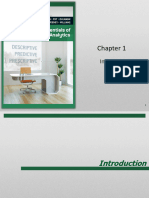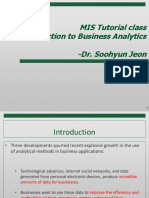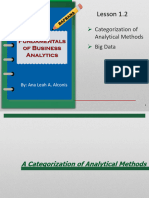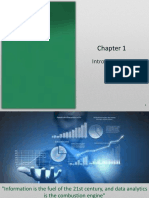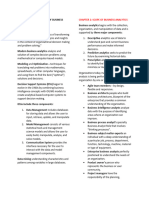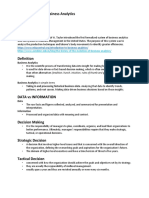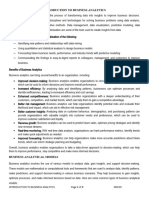Introduction
Introduction
• Three developments spurred recent explosive growth in the use of
analytical methods in business applications:
• First development:
• Technological advances—scanner technology, data collection through e-
commerce, Internet social networks, and data generated from personal
electronic devices—produce incredible amounts of data for businesses
• Businesses want to use these data to improve the efficiency and profitability
of their operations, better understand their customers, price their products
more effectively, and gain a competitive advantage
2
�Introduction
• Three developments spurred recent explosive growth in the use of
analytical methods in business applications: (contd.)
• Second development:
• Ongoing research has resulted in numerous methodological developments,
including:
• Advances in computational approaches to effectively handle and explore massive amounts
of data
• Faster algorithms for optimization and simulation
• More effective approaches for visualizing data
3
�Introduction
• Three developments spurred recent explosive growth in the use of
analytical methods in business applications: (contd.)
• Third development:
• The methodological developments were paired with an explosion in
computing power and storage capability
• Better computing hardware, parallel computing, and cloud computing have
enabled businesses to solve big problems faster and more accurately than
ever before
4
�Figure 1.1:
Analytics Job Trend According to
Indeed.com
�Decision Making
6
�Decision Making
• Managers’ responsibility:
To make strategic, tactical, or operational decisions
• Strategic decisions:
• Involve higher-level issues concerned with the overall direction of the
organization
• Define the organization’s overall goals and aspirations for the future
7
�Decision Making
• Tactical decisions:
• Concern how the organization should achieve the goals and objectives set by
its strategy
• Are usually the responsibility of midlevel management
• Operational decisions:
• Affect how the firm is run from day to day
• Are the domain of operations managers, who are the closest to the customer
8
�Decision Making
Decision making can be defined as the following process:
1. Identify and define the problem
2. Determine the criteria that will be used to evaluate alternative solutions
3. Determine the set of alternative solutions
4. Evaluate the alternatives
5. Choose an alternative
9
�Decision Making
Common approaches to making decisions
• Tradition
• Intuition
• Rules of thumb
• Using the relevant data available
10
�Business Analytics Defined
11
�Business Analytics Defined
• What makes decision making difficult and challenging?
• Uncertain is probably the number one challenge.
• Another factor that makes decision making difficult is that we often
face such an enormous number of alternatives that we cannot
evaluate them all.
12
�Business Analytics Defined
Business analytics:
• Scientific process of transforming data into insight for making better decisions
• Used for data-driven or fact-based decision making, which is often seen as
more objective than other alternatives for decision making
13
�Business Analytics Defined
Tools of business analytics can aid decision making by:
• Creating insights from data
• Improving our ability to more accurately forecast for planning
• Helping us quantify risk
• Yielding better alternatives through analysis and optimization
14
�A Categorization on
Analytical Methods and
Models
Descriptive Analytics
Predictive Analytics
Prescriptive Analytics
15
�A Categorization of Analytical
Methods and Models
• Descriptive analytics: Encompasses the set of techniques that
describes what has happened in the past; examples:
• Data queries
• Reports
• Descriptive statistics
• Data visualization (including data dashboards)
• Data-mining techniques
• Basic what-if spreadsheet models
• Data query: A request for information with certain characteristics
from a database
16
�A Categorization of Analytical
Methods and Models
• Data dashboards: Collections of tables, charts, maps, and summary
statistics that are updated as new data become available
• Uses of dashboards
• To help management monitor specific aspects of the company’s performance
related to their decision-making responsibilities
• For corporate-level managers, daily data dashboards might summarize sales by
region, current inventory levels, and other company-wide metrics
• Front-line managers may view dashboards that contain metrics related to
staffing levels, local inventory levels, and short-term sales forecasts
17
�A Categorization of Analytical
Methods and Models
• Data mining is the use of analytical techniques for better
understanding patterns and relationships that exist in large data sets.
• Analyzing text on social network platforms like Twitter, data-mining
techniques (including cluster analysis and sentiment analysis)
• Categorizing certain words as positive or negative and keeping track
of how often those words appear in tweets
18
�A Categorization of Analytical
Methods and Models
• Predictive analytics: Consists of techniques that use models
constructed from past data to predict the future or ascertain the
impact of one variable on another
• Survey data and past purchase behavior may be used to help predict
the market share of a new product
19
�A Categorization of Analytical
Methods and Models
Techniques used in Predictive Analytics:
• Linear regression
• Time series analysis
• Data mining is used to find patterns or relationships among elements of the
data in a large database; often used in predictive analytics
• Simulation involves the use of probability and statistics to construct a
computer model to study the impact of uncertainty on a decision
20
�A Categorization of Analytical
Methods and Models
Prescriptive Analytics: Indicates a best course of action to take
• Optimization models: Models that give the best decision subject to
constraints of the situation
Model Field Purpose
Portfolio models Finance Use historical investment return data to determine
the mix of investments that yield the highest
expected return while controlling or limiting
exposure to risk
Supply network Operations Provide the cost-minimizing plant and distribution
design models center locations subject to meeting the customer
service requirements
Price markdown Retailing Uses historical data to yield revenue-maximizing
models discount levels and the timing of discount offers
when goods have not sold as planned
21
�A Categorization of Analytical
Methods and Models
Prescriptive Analytics (contd.)
• Simulation optimization: Combines the use of probability and statistics to
model uncertainty with optimization techniques to find good decisions in
highly complex and highly uncertain
• Decision analysis
• Used to develop an optimal strategy when a decision maker is faced with several
decision alternatives and an uncertain set of future events
• Employs utility theory, which assigns values to outcomes based on the decision maker’s
attitude toward risk, loss, and other factors
22
�Summary
Decision making can be defined as the following process:
• (1) identify and dene the problem;
• (2) determine the criteria that will be used to evaluate alternative
solutions;
• (3) determine the set of alternative solutions;
• (4) evaluate the alternatives; and
• (5) choose an alternative.
�Summary
• Business analytics approaches can assist by identifying and mitigating
uncertainty and by prescribing the best course of action from a very
large number of alternatives.
• There are three categories of analytics:
• descriptive,
• predictive, and
• prescriptive.

